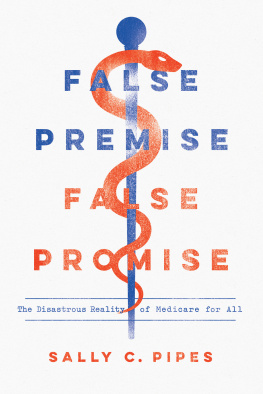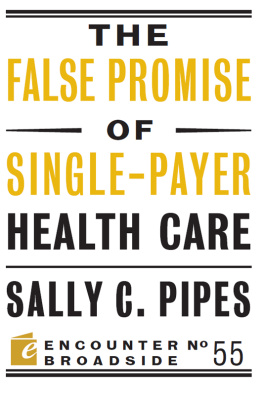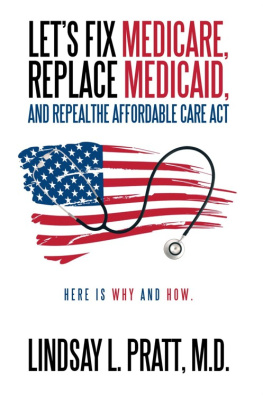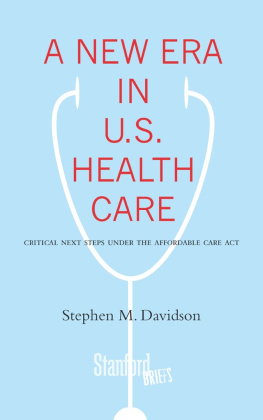
ENCOUNTER BROADSIDES : a new series of critical pamphlets from Encounter Books. Uniting an 18th-century sense of political urgency and rhetorical wit (think The Federalist Papers, Common Sense) with 21st-century technology and channels of distribution, Encounter Broadsides oVer indispensable ammunition for intelligent debate on the critical issues of our time. Written with passion by some of our most authoritative authors, Encounter Broadsides make the case for liberty and the institutions of democratic capitalism at a time when they are under siege from the resurgence of collectivist sentiment. Read them in a sitting and come away knowing the best we can hope for and the worst we must fear.

O N M ARCH 23, 2010, President Barack Obama set in motion the radical remaking of Americas health care system by signing the Patient Protection and Affordable Care Act into law. Three years later, the laws implementation is well under way. But to fully grasp whats ahead, we must take stock of what the law has already done, what Congress can do now, and what a future replacement agenda would look like.
Federal bureaucrats began implementing the 2,700-page law soon after President Obama put pen to paper. By 2013, theyd issued 20,000 pages of regulations.
These rate reviews require insurers to publicly justify premium increases of 10 percent or more. At that point, rate reviews amount to price controls.
Starting in September 2010, all family policies were required to cover children up to age 26. Backers of the provision claimed that it would extend coverage to a demographic with one of the highest uninsured rates: young adults. But its done so at their parents expense, driving up premiums by $151, to $452 per year.
Obamacare tacked on three more cost-inflating mandates in 2010. The first mandate restricted insurance companies from placing lifetime limits or annual caps on the amount of coverage a customer could consume. From 2012 to 2014, no policy can cover less than $2 million in benefits annually, and in 2014, annual caps become illegal. The next mandate banned insurers from denying coverage to children with pre-existing conditions. The third prevented insurers from charging for anything that HHS categorized as preventive care. While popular, all three rules have made coverage less affordable.
In 2011, the feds began directly regulating insurers profit margins with minimum medical loss ratios (MLRs). These rules require insurance companies to spend 80 percent of premiums from the individual and small-group markets and 85 percent of premiums in the large-group market on claims.

Many doctors have seen enough of Obamacare. One 2012 survey found that a third of doctors plan to leave private practice in the next decade.

Insurers are having trouble meeting those standards. According to a February 2013 report by the Centers for Medicare and Medicaid Services, 24.5 percent of private insurers fell afoul of the MLR rules in at least one market in 2011.
Theyll look to avoid those rebates in the future. With most administrative costs fixed, the easiest way for insurers to comply is by raising premiums and simply paying health care providers more money. Thats no way to make coverage more affordable or address our nations health-cost crisis.
Insurers havent been alone in attracting Obamacares ire. In September 2010, the feds began their assault on the pharmaceutical industry by creating the Patient-Centered Outcomes Research Institute (PCORI). This organization will oversee the administrations comparative-effectiveness research efforts and will take its funding from a new fee on insurers. That fee started at $1 per beneficiary in 2012; each year thereafter through 2019, the fee runs $2 per beneficiary.
Comparative-effectiveness research purports to compare treatments against one another to determine which ones work best. But those comparisons inevitably become biased by cost considerations. With health spending spiraling upward, PCORI will face substantial pressure to discover that older, cheaper remedies work just as well as newer, more expensive ones.
Defenders of PCORI claim that Obamacare forbids the agency from dictating coverage mandates or reimbursement levels. But that doesnt mean that private insurers or public payers like Medicare and Medicaid cant use the centers findings to adjust coverage and reimbursement decisions.
In 2012, the Obama administration lobbed a more direct volley at the pharmaceutical industry, extracting billions of dollars in new excise taxes calculated according to the previous years sales volume. Obamacare collects these fees from the sector annually. Drug makers will doubtless pass them along to consumers. Future generations will pay this tax, too, as it will divert money that would have been invested in the research and development of new cures to the federal Treasury instead.
Obamacare is also attempting to kill off the traditional private medical practice in favor of Accountable Care Organizations (ACOs), which came into being in 2012. These networks of providers are supposed to coordinate Medicare patients care and thereby eliminate unnecessary or wasteful treatments. By the beginning of 2013, HHS announced that it had approved 106 new ACOs, bringing the nationwide total to more than 250.
ACOs force doctors and hospitals to assume significant financial risks and administrative burdens. Providers must absorb any losses they incur if they fail to realize the savings that regulators demand. They must also collect all sorts of data on health care quality. That data may be useful but the infrastructure for obtaining it will cost billions. For all that extra spending, HHS expects to save $960 million from this arrangement over three years.
Many doctors have seen enough of Obamacare. One 2012 survey found that a third of doctors plan to leave private practice in the next decade. They have every right to be. After all, Obamacares most disastrous provisions have not yet taken effect.
But they will over the next two years. What fresh nightmares can Americans look forward to?
2013
This marks the first year that many of Obamacares onerous rules, regulations, and taxes take effect. But the laws signature insurance exchanges are commanding the attention of those charged with implementing it.
Insurance Exchange Uncertainty
Obamacares authors made insurance exchanges now rebranded as marketplaces a central feature of their plan to expand access to health care, but their creation hasnt gone as smoothly as they had hoped. In April 2013, Senator Max Baucus (D-Mont.), the Senate Finance Committee chairman and one of the architects of the law, spoke with Kathleen Sebelius, the secretary of HHS, at a hearing on the exchanges. I see a huge train wreck coming down, he said. He went on to say, Im very concerned that not enough is being done so far very concerned.

















